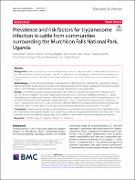| dc.description.abstract | Bovine trypanosomosis transmitted by tsetse fies is a major constraint to cattle health and productivity in all sub-Saharan countries, including Uganda. The objectives of this study were to determine the prevalence of
bovine trypanosomosis and identify its associated risk factors and the species of trypanosomes associated with the
disease.
A cross-sectional study was conducted around Murchison Falls National Park, Uganda from January
2020 to April 2020. Trypanosomes were detected in blood samples by PCR analysis targeting the internal transcribed
spacer 1 (ITS-PCR assays), and trypanosomes in positive blood samples were sequenced.
Of 460 blood samples collected and tested, 136 (29.6%) were positive for trypanosome infections and
324 (70.4%) were negative. The overall trypanosome prevalence was 29.6% (95% confdence interval 25.4–33.8%),
attributed to three trypanosome species. Of these three species, Trypanosoma vivax was the most prevalent (n=130,
28.3%) while the others were detected as mixed infections: T. vivax+Trypanosoma congolense (n=2, 0.4%) and T.
vivax+Trypanosoma evansi (n=1, 0.2%). There were signifcant diferences in trypanosome prevalence according to
sex (χ
2=62, df=1, P<0.05), age (χ
2=6.28, df=2, P=0.0043) and cattle breed (χ
2=10.61, df=1, P=0.001). Trypanosomosis remains a major limitation to cattle production around Murchison Falls National Park
and interventions are urgently needed. In our study, the prevalence of trypanosome infections was high, with T. vivax
identifed as the most prevalent species. Age, sex and breed of cattle were risk factors for trypanosome infection. | en_US |


